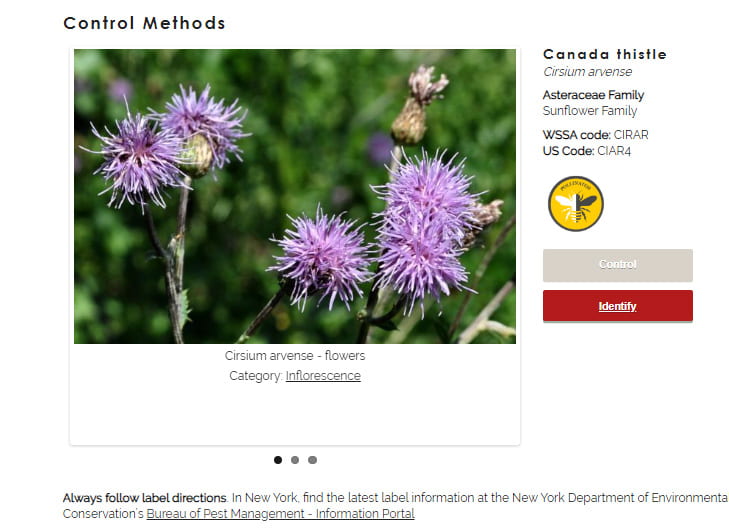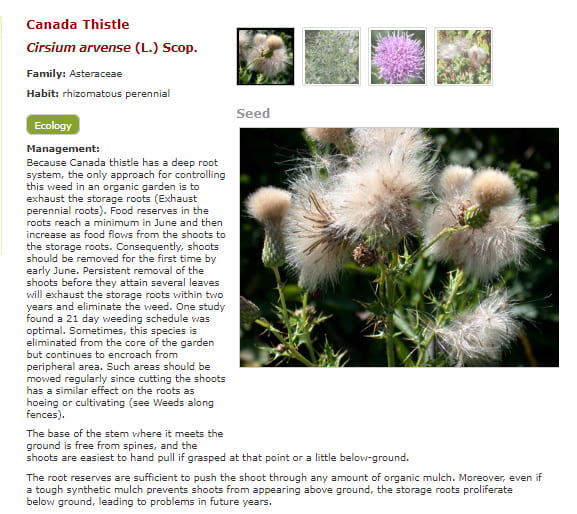Canada thistle (Cirsium arvense), is a spreading perennial weed of crops, pastures, and disturbed sites. It is most troublesome in perennial crops, rangeland, and areas where reduced tillage is practiced. Canada thistle spreads through both seeds and budding from underground roots. Its root system can extend more than fifteen feet out and six feet down from the plant, making management difficult. It is found throughout the northern half of the United States and southern Canada.
Identification
Seedlings: When sprouting from seed, cotyledons are dull green, relatively thick, rounded-oval to oblong (Fig.1). Many new plants sprout from root (rhizome) fragments, and lack cotyledons. Young leaves are thick, egg-shaped to spear-shaped with wavy-lobed, spiny edges; the whole leaf is covered with short, bristly hairs (Fig. 2). Seedlings form a basal rosette and then elongate later in the season.

Fig. 1. Canada thistle cotyledons and early leaves. Photo from “Weed Identification, Biology and Management”, by Alan Watson and Antonio DiTommaso.
Mature plant: Stems are upright and 0.3-1.2 m (1-4′) tall, grooved, and with no hairs or just a few hairs. The stems are also slender and branched at the top. The mature plant grows in groups/patches.
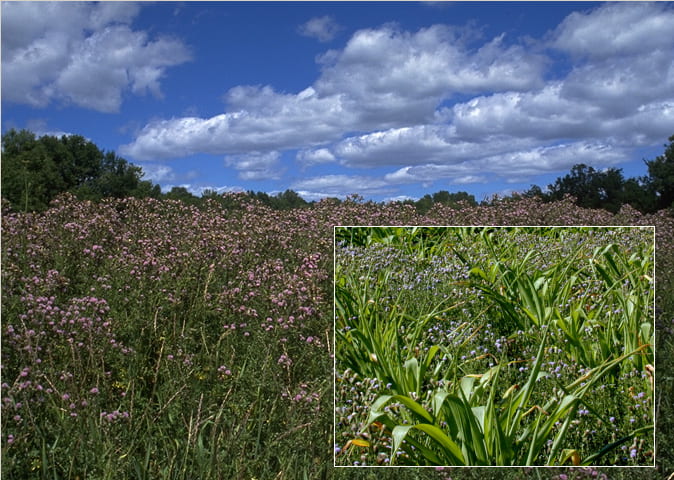
Leaves: On mature plants, leaves are alternate and are egg- to lance-shaped with irregular lobes, no petiole, and spiny edges. The base of each leaf surrounds the stem.
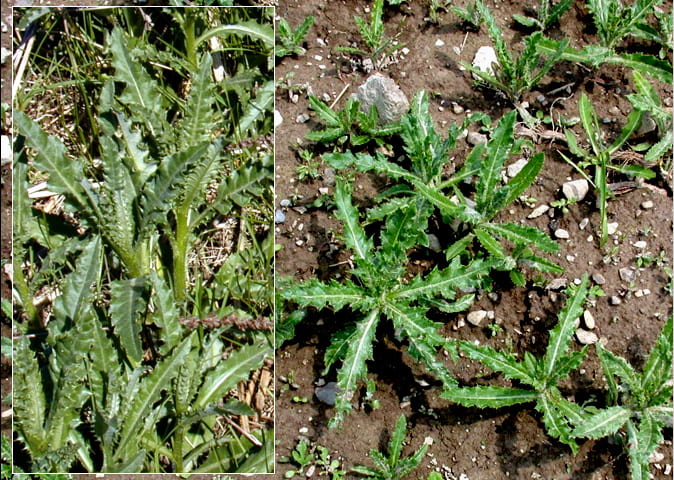
Fig. 2. Canada thistle seedlings. Photo from “Weed Identification, Biology and Management”, by Alan Watson and Antonio DiTommaso.
Flowers/Seeds: Flowers are present from June through August, with multiple flowers per stem. Flower heads are about an inch wide, and have pink to purple (or rarely white) flowers surrounded by spineless bracts (Fig. 3). Male and female flowers are produced on separate plants. Seeds are produced singly in a flat, brown fruit about 1/10 of an inch long. Seeds are curved or straight, with the tip abruptly cut off and a bump in the center (Fig. 4). Seeds produce a feathery pappus (similar to dandelion ‘seeds’) which help disperse the seeds (Fig. 4).
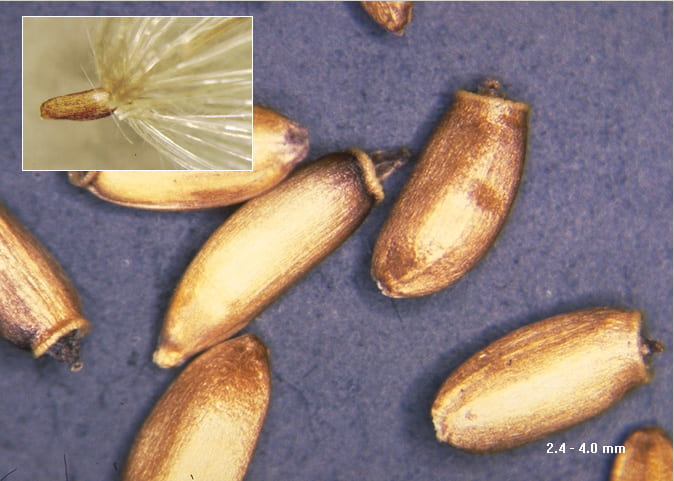
Fig. 4. Canada thistle seeds. Photo from “Weed Identification, Biology and Management”, by Alan Watson and Antonio DiTommaso.
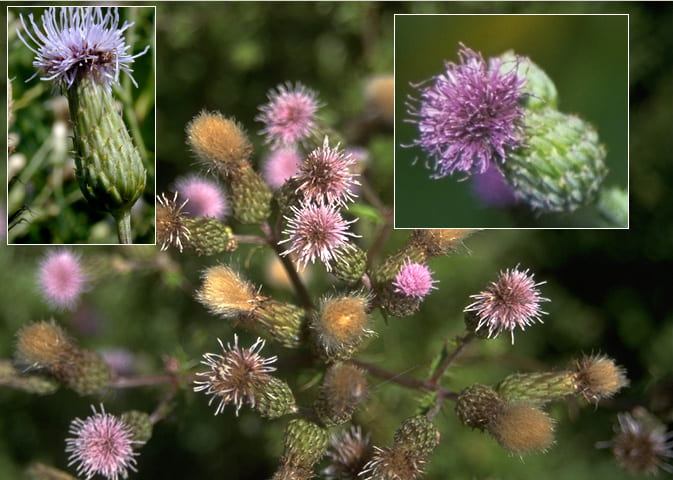
Fig. 3. Canada thistle flowers. Photo from “Weed Identification, Biology and Management”, by Alan Watson and Antonio DiTommaso.
Herbicide Resistance: Currently there are no reports of herbicide resistance of Canada thistle in the US.
Management
Several factors make Canada thistle especially hard to manage. Vegetative reproduction from the extensive root system can occur whenever it is stressed as well as in the spring and fall. Seeds can persist over twenty years in the soil. Reproduction from the root system means any treatment that does not affect the roots is largely ineffective. Any treatment, chemical or mechanical, will need to be repeated for several years. Canada thistle can be suppressed by crops that create substantial shade in the spring, such as alfalfa and winter wheat. A mixture of cultural, mechanical, and chemical control methods is often most effective.
Chemical control
Cornell University’s Turfgrass and Landscape Weed ID app offers suggestions for conventional and alternative chemical control options. Generally, treatments between June and September have been most effective. Pennsylvania State University has useful management advice focused for the Conservation Reserve Management Program. Techline has published the results of a study comparing Milestone rates and Milestone or Tordon applications at different times in North Dakota.
In apple orchards, post-emergent clopyralid applications can help control Canada thistle. Some pre-emergent herbicides (dichlobenil and rimsulfuron) and post-emergent burndown herbicides (glufosinate, pyraflufen-ethyl and saflufenacil) can be used against thistle as well. See this ENYCHP Tree Fruit News article for details.
Use this tool to look up the efficacy of herbicides on a particular weed species. For general guidance on weed control, get the latest edition of the Cornell Crop and Pest Management Guidelines.
Non-chemical control
Cornell University’s Weed Ecology and Management website provides ecological control options for Canada Thistle. Persistent cultivation can be effective over several years, as can competition from dense crop cover or cover crops. The University of Nebraska also has a page devoted to organic Canada thistle management, as does North Dakota State University.
See A Grower’s Guide to Organic Apples from Cornell for non-chemical weed control options in apple orchards.
References
Uva R H, Neal J C, DiTomaso J M. 1997. Weeds of the Northeast. Book published by Cornell University, Ithaca NY. The go-to for weed ID in the Northeast; look for a new edition sometime in 2019.
Cornell University’s Weed Ecology and Management website. Contains a wealth of information on ecological management of agricultural and garden weeds. Look for a revamp of this site in 2020 or 2021.
Cornell University’s Turfgrass and Landscape Weed ID app. Identification and control options for weeds common to turf, agriculture, and gardens in New York; uses a very simple decision tree to identify your weed.
Colorado State University Extension Canada thistle fact sheet. This is an excellent review of effective management, but please keep in mind that New York’s pesticide regulations are much stricter than Colorado’s, and some of these treatments may not be legal in New York.
Techline Invasive Species Management’s Canada thistle management reports from studies in North Dakota, here and here. please keep in mind that New York’s pesticide regulations are much stricter than North Dakota’s, and some of these treatments may not be legal in New York.
North Dakota State University: Organic Management of Canada Thistle.
University of Nebraska-Lincoln: Managing Canada Thistle in Organic Cropping Systems.
University of Nebraska Cooperative Extension: Managing Canada Thistle.
Pennsylvania State University: Managing Canada Thistle.
Identification profile for Canada Thistle by the University of California Statewide Integrated Pest Management Program.
Basedow, M and L Sosnoskie. 2020. Strategies for Dealing with Pesky Perennial Weeds. Article published in the April 2020 issue of Tree Fruit News. Covers control of yellow nutsedge, Canada thistle, field bindweed, and dandelion in apple orchards.
Peck, G M and I A Merwin. A Grower’s Guide to Organic Apples. Covers organic weed control methods for organic apple orchards.
Breth, D I and E Tee. 2016. Herbicide AI by Weed Species. This tool allows you to look up the efficacy of an herbicide active ingredient on a particular weed species.

